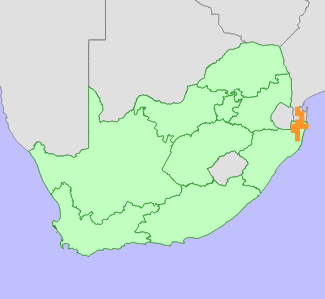|
Scientific Name | Pavetta vanwykiana Bridson |
Higher Classification | Dicotyledons |
Family | RUBIACEAE |
Common Names | Sand Brides-bush (e) |
National Status |
Status and Criteria | Least Concern |
Assessment Date | 2016/11/21 |
Assessor(s) | H. Matimele, D. Raimondo & J.E. Burrows |
Justification | Pavetta vanwykiana is a range-restricted endemic to the Maputaland Centre of Endemism, with a National Extent of Occurrence of 6639 km². It is fairly common, and appears to be resilient to disturbance, and therefore it is not considered in danger of extinction. |
Distribution |
Endemism | Not endemic to South Africa |
Provincial distribution | KwaZulu-Natal |
Range | The species is known from Mkuze Game Reserve in KwaZulu-Natal, South Africa northwards through Ndumo Game Reserve and Tembe Elephant Park to Mozambique, where it is found in the Licuati Forest Reserve and as far north as Porto Henrique. |
Habitat and Ecology |
Major system | Terrestrial |
Major habitats | Forest, Indian Ocean Coastal Belt, Savanna |
Description | Pavetta vanwykiana is a geoxylic suffrutex, and occurs in well-drained sandy soils in open woodland, sand forest or thornveld on the coastal plain to about 100 km inland from the coast (Boon 2010). It has annual or short-lived aerial parts but with a large subterranean rootstock, and is able to survive fires and habitat degradation. It thrives in open areas which are increasing due to forest clearing. |
Threats |
| There is extensive, ongoing loss and degradation of natural vegetation across the Maputaland coastal plain as a result of expanding crop fields, settlements, overgrazing, and clearing of woody vegetation for fuel and construction materials. P. vanwykiana is however able to withstand fire and clearing of woody vegetation. It occurs most often in clearings, and loss of woody cover due to forest clearing is suspected to be increasing available habitat. |
Population |
There have been no population counts for P. vanwykiana. Herbarium collections and a study by Graham et al. (2012) indicate that it is fairly common within and outside of protected areas in northern KwaZulu-Natal. As there are no severe threats to the species, the population is not suspected to be declining.
|
Population trend | Stable |
Assessment History |
Taxon assessed |
Status and Criteria |
Citation/Red List version | | Pavetta vanwykiana Bridson | Least Concern | Raimondo et al. (2009) | |
Bibliography |
Boon, R. 2010. Pooley's Trees of eastern South Africa. Flora and Fauna Publications Trust, Durban.
Bridson, D.M. 2001. Additional notes on Pavetta (Rubiaceae: Pavetteae) from Tropical Eastern and Southern Africa. Kew Bulletin 56(3):567-600.
Graham, M., De Winnaar, G., Cowden, C., Styles, D. and Harvey, J. 2012. Basic assessment for the Candover-Mbazwana, Mbazwana-Gezisa Eskom distribution 132kV powerlines and Mbazwana and Gezisa 132/22kV substations, northern KwaZulu-Natal. Unpublished Biodiversity Report. GroundTruth.
Raimondo, D., von Staden, L., Foden, W., Victor, J.E., Helme, N.A., Turner, R.C., Kamundi, D.A. and Manyama, P.A. 2009. Red List of South African Plants. Strelitzia 25. South African National Biodiversity Institute, Pretoria.
|
Citation |
| Matimele, H., Raimondo, D. & Burrows, J.E. 2016. Pavetta vanwykiana Bridson. National Assessment: Red List of South African Plants version 2024.1. Accessed on 2025/10/16 |
 Comment on this assessment
Comment on this assessment

